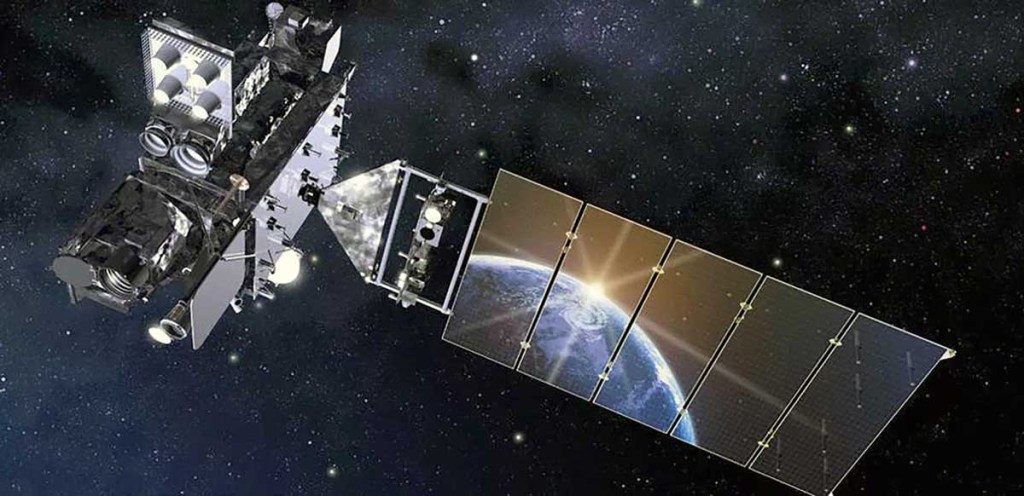OUR SPACE: There goes GOES-U
Published 8:38 am Tuesday, July 2, 2024

- The GOES-U satellite featuring the Compact Coronagraph (CCOR). CCOR will be located on the GOES-U Sun Pointing Platform alongside the Solar Ultraviolet Imager (SUVI) and Extreme Ultraviolet and X-Ray Irradiance Sensors (EXIS) instruments. CCOR on GOES-U will observe the Sun’s corona to detect Coronal Mass Ejections (CMEs).
The world of meteorology (and any Weather Channel afficionado) has a new superstar: the GOES-U satellite, which launched successfully into orbit last Tuesday. It was a textbook launch on a picture-perfect day at Cape Canaveral, and the 27 Merlin engines in the triple-rocket Falcon Heavy boosters put on a spectacular show!
Loyal OUR SPACE readers will of course remember other GOES satellites. GOES stands for Geostationary Operational Environmental Satellite, and the U represents its alphabetical place in a long-running series of Earth-observing satellites. GOES-U is a member of the so-called “R-Series,” and the final one in this configuration. Operated by NOAA (National Oceanic and Atmospheric Administration) it will ensure top-notch weather science until well into the 2030s.
Trending
GOES-U is about the size of a small school bus, so it’s really big for a weather satellite. Getting this behemoth off the ground required the raw muscle of the SpaceX Falcon Heavy booster set — essentially three rockets tied together, with the two on the outside providing the extra power needed for those first few minutes after launch. GOES-U weighs in at over 10 tons, fully loaded, with propellant to last around 15 years, so yes, this is quite the monster. It will make its way into geostationary orbit, meaning that it will remain in place over a specific area and match its orbit with Earth’s rotation. A five-section solar panel will provide the electricity needed to operate its science payload. Over the next year or so the spacecraft will gradually ease into its final position while calibrations and tests are conducted. By now GOES-U has been renamed GOES-19 and will eventually replace the GOES-16 satellite as it nears the end of its life span.
But GOES-U (and indeed the other GOES satellites) is much more than a weather satellite: its sun-facing side will study our local star in great detail and provide images in multiple wavelengths, contributing to the forecast of space weather — the ionized plasma hurled towards Earth by the sun, which can cause havoc for lots of other satellites, poses a real danger for astronauts working aboard the International Space Station (ISS) and can even impact the electrical power grid on the ground. With the current heat wave nobody wants to lose their AC!
GOES-U will study clouds, aerosols, smoke from wildfires and volcanism and the resulting dangers to air quality, water vapor in the atmosphere, and the so-called atmospheric rivers, which have been in the news a lot lately, as they bring intense rainfall which in turn can cause landslides and catastrophic flooding. It will also monitor and map lightning and those rotational clouds that might signal the formation of a tornado or hurricane. There’s very little that this satellite can’t do — it really is the whole package when it comes to monitoring our environment. When plants are stressed due to lack of precipitation, the GOES satellites can recognize and monitor those situations as well.
Oh yes, and it takes awesome pictures of Earth!
GOES data will be available through NESDIS, the National Environmental Satellite, Data, and Information Service, which is a branch of the Department of Commerce. Any time you open the weather app on your phone or turn on your TV to watch the forecast, you are witnessing data from a GOES spacecraft turned into useful information for daily life.
Since the booster for GOES-U consisted of three rockets, viewers were treated to a rare view — the return of two boosters to the launch pads. The regular booster return is always exciting and provides a bonus spectacle just minutes after launch, but to see two of them making the return trip in tandem is quite mind-blowing. The third or middle booster didn’t make it back, however. Due to the high orbit required for this satellite, the booster had to keep burning its fuel to the last drop, leaving nothing for a precise landing. A geostationary orbit is well over 22,000 miles up, so it’s a long trip. The upper stage of the middle booster provided the final push to that altitude. It, too, was discarded after that, as the satellite is now using its on-board fuel to make final orbital and orientation adjustments.
Trending
NOAA and NASA are already busy working on the successors for the GOES-R series, a brand-new system called GeoXO, short for Geostationary Extended Observations, which will launch in 2032 or thereabouts. Of course, those satellites will be even better than what we have now; as technology progresses and new science instruments become available. The NOAA satellites have never been one-trick ponies — they’ve always been packed to the gills with sensors and cameras. Once the latest member of the family becomes operational, we will have near-instantaneous access to the most up-to date weather data, ultimately saving lives by precisely forecasting dangerous weather and environmental hazards.
Learn more about the GOES satellites at https://www.goes-r.gov/ — there are even instructions on how to build a GOES-R model with legos, plus games, videos and much more!
Beate Czogalla is the Professor of Theater Design in the Department of Theatre and Dance at Georgia College & State University. She has had a lifelong interest in space exploration and has been a Solar System Ambassador for the Jet Propulsion Laboratory/ NASA for many years. She can be reached at our_space2@yahoo.com






